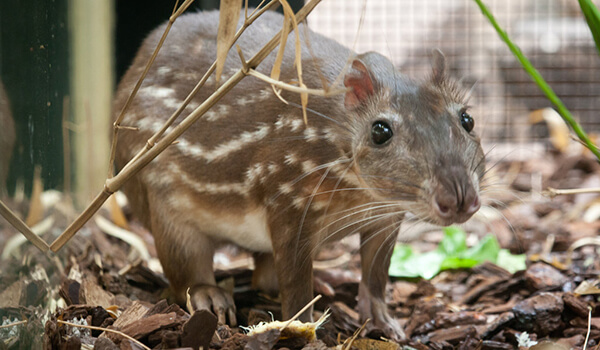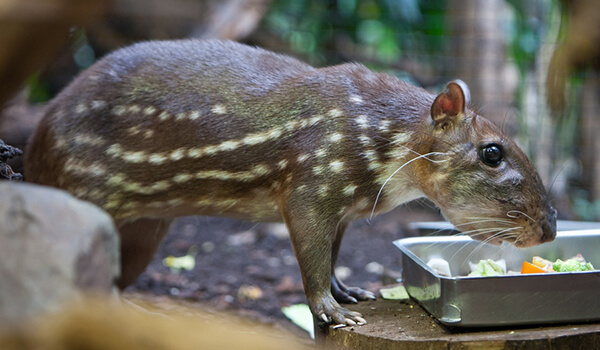Life Behind the Silence: Everything You Need to Know About the Paca Animal
Are you ready to meet one of the most silent, mysterious, and yet utterly fascinating creatures in nature? The spotlight rarely shines on this animal. It’s hardly ever featured in documentaries, and most people have never even heard of it. Yet, deep in the heart of tropical forests, a shadow moves quietly through the night. That shadow belongs to the paca.
What Is a Paca?
The paca (Cuniculus paca) is a large rodent native to Central and South America. Known by different local names like majaz, tepezcuintle, or borugo, it is closely related to agoutis and shares distant ties with the capybara. The paca stands out among rodents with its size, behavior, and lifestyle.
Scientific Classification:
Appearance: The Beauty Beneath the Stripes
At first glance, the paca’s appearance is striking. Its body is robust, with noticeably longer hind legs than front legs. The fur is dark brown, featuring rows of white spots and stripes along each side of its body. These markings serve as both camouflage and a unique identifier.
Length: 60–80 cm (24–31 in)
Weight: 6–14 kg (13–31 lbs)
Tail: Very short, almost invisible
Lifespan: Around 12 years in the wild
It’s often larger than a house cat, and far more elusive.
Where Do Pacas Live?
Pacas live in tropical and subtropical forests, often near water sources such as rivers, streams, and swamps. Water plays a vital role in their survival, as they are excellent swimmers and often escape predators by diving into nearby water.
Natural Habitat Regions:
Amazon Rainforest
Central America (Panama, Costa Rica, Honduras)
Northern South America (Venezuela, Colombia, Peru, Brazil)
They dig burrows into riverbanks or soft forest floors, usually with more than one entrance for quick escapes.
Behavior: Quiet Solitude
Pacas are solitary by nature. They are not social animals and establish a personal territory, which they mark with scent to ward off others. As nocturnal creatures, they are most active at night, roaming the forest in search of fruit and seeds.
Interesting Traits:
Exceptional hearing; they can detect even the faintest movement.
When threatened, they stomp or flick their tail to create a warning sound.
Their presence is often noticed only by the faint white dots on motion-activated cameras at night.
What Do They Eat?
Pacas are strict herbivores and particularly fond of fallen fruits. They also eat nuts, seeds, and occasionally fungi. With a slow metabolism, they chew their food thoroughly and eat unhurriedly.
Their diet makes them essential seed dispersers, playing a crucial role in the natural regeneration of the forest. In that sense, they are the “silent gardeners” of the rainforest.
Reproduction and Parenthood
Pacas reproduce once or twice a year. The gestation period lasts about 115–120 days, and usually, a single baby is born. Remarkably, the newborn can stand and walk shortly after birth.
The mother carefully builds the burrow with multiple exits, providing an escape route if predators appear. This strategy greatly increases the baby’s chances of survival.
Relationship with Humans: Ethical and Ecological Concerns
In some regions, paca meat is considered a delicacy and is hunted for food. While it serves as a protein source for some local communities, overhunting and habitat destruction have led to population declines in several areas.
Today, pacas are protected in many countries. Some sustainable farms have even started raising them ethically to avoid harming wild populations.
Cultural Reflections
Among some Indigenous cultures in South and Central America, the paca is seen as a symbol of quiet wisdom. In Amazonian folklore, it is sometimes believed to be a messenger of the forest spirit, a guardian of natural balance.
Ecological Importance
The paca’s role in its ecosystem is far more significant than its quiet nature suggests. By spreading seeds across the forest, it supports biodiversity and the natural cycle of life. Indirectly, it also helps feed other animals and contributes to the overall health of the forest.
Final Thoughts: The Power of the Unseen
The paca teaches us a powerful lesson: every creature has a purpose in nature, even if we don’t always see it. It lives in silence, leaves almost no trace, yet helps shape the forest in its own quiet way.
Learning about the paca isn’t just discovering a new animal — it’s recognizing the hidden heroes of nature, and understanding that greatness often hides in the shadows.
So, if you ever find yourself walking through a tropical rainforest and hear a faint rustle in the underbrush… don’t be alarmed. It might just be a paca, watching you quietly, as it always does — from the heart of the forest.











